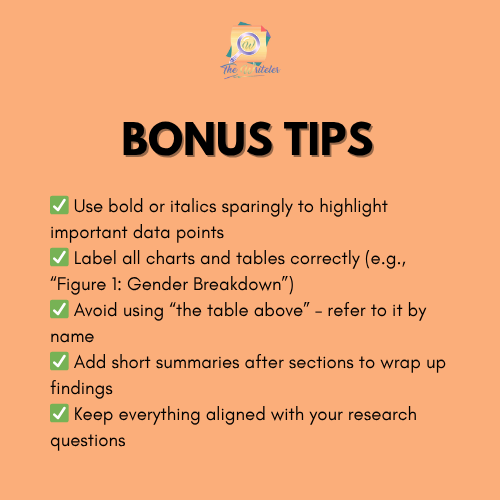Let’s be honest—Chapter 4 often gets a bad rap. Many students either overcomplicate it with jargon or make it so dull that even their adviser zones out. However, Chapter 4 is where your research comes alive. It’s where you show what your data means and how it connects to your research questions.
The good news? Writing Chapter 4 doesn’t have to be boring. In fact, with the right structure and tone, you can keep your reader engaged while staying academically sound. Here’s how.
Understand the Purpose
Before you begin writing, it’s important to know what Chapter 4 is meant to do. This section is where you present your research results—whether that’s numbers, themes, or patterns.
While Chapter 3 explains how you gathered your data, Chapter 4 shows what that data reveals. It should be:
- Clear and easy to follow
- Free from excessive interpretation (save that for Chapter 5)
- Aligned with your research questions and hypotheses
Structure for Clarity
To avoid confusion or boredom, start by organizing Chapter 4 with a logical structure. You can use these common formats depending on your research type:
For Quantitative Research Chapter 4:
- Restate research questions or hypotheses
- Present descriptive statistics (mean, median, frequency, etc.)
- Show inferential statistics (t-tests, ANOVA, regression, etc.)
- Use charts and tables to simplify data
For Qualitative Research:
- Restate the main research questions
- Summarize emerging themes
- Use participant quotes to illustrate points
- Add a brief transition to Chapter 5 (analysis)
Using clear headers for each section helps readers follow your findings without feeling overwhelmed.
Make Chapter 4 Reader-Friendly
Even if you’re presenting raw data, your tone matters. To keep Chapter 4 engaging:
- Avoid walls of text – Break content into short paragraphs.
- Explain figures and tables clearly – Don’t assume readers know what they’re seeing.
- Use everyday language when possible – You can be smart and simple.
- Start with a short overview before diving into numbers or quotes.
Example:
“This section presents the responses from 100 survey participants. Table 1 shows the average score for each item related to student motivation.”
This is simple, clear, and easy to understand.
Avoid Common Mistakes
To keep your writing sharp and focused, avoid these mistakes often found in Chapter 4:
- ❌ Repeating the same results in text and tables
- ❌ Over-explaining obvious findings
- ❌ Using technical terms without explaining them
- ❌ Jumping to interpretation (wait until Chapter 5!)
Instead, be concise and use your data to build a strong foundation for the next chapter.
Use Transitions to Guide Readers Through Chapter 4
Smooth transitions make your writing feel polished. Use words and phrases that connect one part of Chapter 4 to the next.
Try using:
- “In addition to…”
- “As shown in the following table…”
- “The next section presents…”
- “Compared to the previous variable…”
These simple connectors keep your ideas flowing and your reader on track.
✍️ The Writeler Co. Can Help You Write Chapter 4 Like a Pro
The Writeler Co. is here to support students and professionals who are juggling research with work, life, and business. Whether you’re writing a thesis, capstone, or dissertation for your master’s or Ph.D., we help you efficiently navigate the research journey — from brainstorming to proofreading.
📩 Message us today to get started.
📚 Let’s turn your research idea into a powerful paper.
Extra Tips for a Non-Boring Chapter 4

Conclusion
Writing Chapter 4 doesn’t have to feel like dragging your reader through a swamp of numbers and quotes. With a clear structure, readable language, and a confident tone, you can make this chapter one of the strongest parts of your paper.
Remember, your goal is to present findings clearly—not impress with complexity. Let your data shine by guiding your reader through it with ease.
And if you ever need help, The Writeler Co. is always ready to assist.





0 Comments